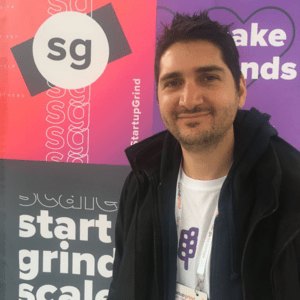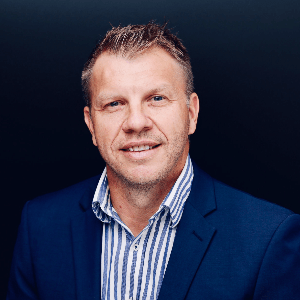As VP of Growth at EuroVPS, I had to make a LOT of decisions, daily. This got exhausting, especially if I had multiple good ideas on how to do something, but wasn’t sure which to choose. Moments like these inspired me to build GrowthMentor. Does this resonate? If so, I’d love to try and help you.
It’s not so complicated: Sales strategy for startups
How do we create demand?
People have to see value.
As Gavin Tye emphasised, figuring out what problem you really solve as a business is the most important element.
For example, GrowthMentor seems like selling mentoring services.
But the actual value is in saving so much time off people’s learning curve that the business gets accelerated
You’ll hear about:
- Repetition in sales strategy
- Maximising the value by identifying the problems a business is solving
- Best practices around sales strategy
- Walking before running, and iterating
- Asking the right questions to stay in the conversation
And all these in less than 25 minutes.
Transcript
Foti Panagio: Hi Gavin, thank you so much for jumping on a call with me today. I’m really excited to talk sales with you, and particularly sales strategy. So sales strategy, I mean, what what’s the difference between sales strategy to you and like just sales?
Gavin Tye: Thanks, man. Thanks for having me. So I’ve started in enterprise B2B sales for startups back in 2015. And I really, I come in, and I’ve never been in software sales before I come from a blue collar recruitment background, so I didn’t know how to sell software stuff. And I went, Okay, well, what does it I learned what a go to market strategy was, I learned how to do lead gen. And I learned all those things, as much as you could learn them and got all the information together, went out went to the market, and right, this is just how we’re gonna this go to market strategy? Did all that market student buy? Like, what are we missing? Like there’s something not going on? Because the market buys from the markets meet? So the seller meets the buyer, and it’s shown around and around and around in different markets, as like, what’s your strategy? Or what are we missing? So that sent me on a journey from 2015 to today about learning about sales strategy. And sales strategy, in my mind, has to be has to be repeatable and has to be the same across all industries, you just apply that strategy and pull the levers that makes suit makes sense for a different different markets. And that’s what I’ve been working on. And I’m really surprised. No one else really talks about it. There’s methodology. And that’s common, you know, the medic principles. That’s a great methodology. You’ve got Miller Heiman, their methodologies, or you’ve got sales process that’s implementing the methodology. But no one really talks about sales strategy. And it’s, it’s surprising.
Foti Panagio: Why why do you think that is?
Gavin Tye: I don’t, I’m not sure. I’m not sure. Like, I think they just most people approach an interaction with someone from their own perspective, right. And when people or businesses they’re tasked with or have to go out and sell, they think that they have a sales problem. So they go out and approach it from a sales perspective, I need to do this much activity, I know a certain percentage isn’t going to work. So if I’ve got a 10% response rate or success rate, I have to make 10 calls to one sale, right? That’s their perspective. But it doesn’t matter. If your clients don’t decide to buy, it doesn’t matter how much you try to sell. You can’t buy you can’t sell anything. So they’re focusing on the wrong thing. So the strategy should be focusing on helping people buy. And traditionally when you say that, how do you create demand? People go, that’s a marketing function. And it’s just not a marketing function at all. Like it’s a it’s a how to get people to buy. And that’s why I think it gets confused. So people go, Oh, demand, that’s marketing. That’s not sales. And it’s a really, it’s just messed up. There’s a lot of, there’s a lot of literature out there that that confuses people. And it’s almost right. And that’s the most dangerous thing. It’s almost right. But it doesn’t actually doesn’t actually help. So I just think there’s so much literature out there, people are just following stuff that’s been written and people get somewhat success, some success, but not not repeatable, scalable success, right? So
Foti Panagio: How do you generate demand using sales? If sales is kind of more of a generally it’s more of a reactive thing. So you have your marketing at the top of the funnel, collecting marketing, qualified leads, and then they come down into some guy CRM and sales, they’re gonna process it but what what do you suggest is an alternative approach to this?
Gavin Tye: Just just in no statements alone, when top of the funnel and marketing and all that’s just rhetoric, right, that’s out there in the market.
Foti Panagio: That’s why I mentioned I’m not provoking you.
Gavin Tye: Oh, no, no, no, no, it’s great. Like you’re saying what everyone does, right top of the funnel? How do we get interest? And it’s, I think you first need to understand, we need to recognise and fundamentally understand we all make decisions the same way. Like if we can, we have to agree on first and foremost, a sale is a consequence of someone deciding to buy right like I you walk into an electrical appliance store, it doesn’t matter how much they try to sell you a TV, if you’re not interested, and you’re not ready to do that. It doesn’t matter. You’re not going to do it, you’re not going to buy so in every interaction you have to decide to buy than the market console. Do. Would you agree with that? Right. So okay, well then how do we create demand and we have to have people have to see value like and, and that first and foremost is where how to create demand well, people typically buy something to solve a problem in their life like and you have to be interested in, you have a problem or you’re interested in something. So figuring out what you really solve as a business, or what you really selling as a salesperson, and what value you offer is the first, first and foremost, the most important thing you need to figure out. Like, with instant, for instance, with growth mentor, your, it seems like you’re selling mentoring services, but you’re actually taking shaving a so much time off people’s learning curve, that the business gets benefit of accelerated, like smarter people within a business be able to generate more revenue faster, be able to accelerate the roadmap be able to make less mistakes within their business. That’s what you’re selling through mentoring on the platform, right? So recognising what you’re selling, and then finding the market that that appeals to most, or the problems or the direct opposite to what you’re selling would maximise your value. And then you just working on longer, like a an interest, like you’re getting interest defining the problem, making sure your requirements meet those maximise the value in our eyes by solving that problem. And that’s how you create value. And then people will need you in their business if you do it the right way.
Foti Panagio: So to kind of sum up, the way I understood it, it’s that you have to take a look for an honest look at your own product or service or whatever it is that you’re you’re you’re selling. Look at your customers, your ideal customers that you want to attract, and really dig in and understand what value they’re getting from it. Right, and then kind of use that, package it up and put it in your sales collateral, which is kind of the segue into the next question. So that from a practical perspective, like how do we how do we actually what do you propose is the correct methodology or best practices for for working sales strategy in the way that you’re suggesting here?
Gavin Tye: Well, it’s, it’s testing like, without putting it into collateral, you really need to test the message. And I’ll give you an example. Like I’m mentoring on the platform. But my day job is an enterprise SAAS salesperson. So there’s a in Australia, here, there’s a movement in industry with, with critical asset operators in the country need to actually make a change in their work the way they manage workforce compliance. It’s a boring topic, but it’s so what I’m doing, I understand the framework, what I’m doing is, I’m going in and I understand the unique features of our platform or the outcomes that we provide. So I’m framing the message in a way to teach them something that they’re not, they’re not thinking about the problem. So I’ve taught them in a way, but in a way of creating the problem that our solution or highlighting the problem or highlighting all the indirect costs, that I know our solution can solve. So what I’m doing is turning that problem from a, let’s call it a 30-or-$40,000 problem to a $400,000 problem, and saying, Did you know you had all this? This is issues in your business? I’ve gone I’ve never thought about about it like that. And then I’m working on my messaging as I do it. And then I’ll say, let me show you our solution. So I’m moving them along to show them an outcome. And then okay, yeah, that makes sense. So go, right, that messaging, right, that works. Let’s see if we can test that again, with other customers or other potential clients. And then if we can get a repeated outcome from that messaging, then we’ll start turning it into webinars or or collateral, because we’ve been out in the field and tested it and getting an outcome. And then we go, right, okay. So I would walk before you run. So and that’s what we’re doing today. Today, we talked about, hey, this has worked with these five clients, I think we can put this in a webinar and go out to 100 clients to test it again, before we go out to the rest of the 1000 people in Australia who were affected. So small, incremental steps, and people try to automate too quick or go quickly from. Hey, that’s our messaging, let’s put it in a marketing collateral without any real feedback if if it gets a desired outcome. Does that make sense?
Foti Panagio: Oh, yeah, you know, reminds me of kind of how I run Google ads, right. You’ll, you’ll test a couple of different creatives, and maybe you’ll put $10 a day on it, right? And with a couple of days, you’ll you’ll kind of see some indicators, not even from conversion rates, but just kind of like click through rates, so more of the funnel metrics, and then decides what you’re gonna do. You’re gonna kill the creatives or scale them are so on and so forth. And I think that with sales, people don’t really do that. They just jump straight into sending 100 emails a day or you know, thermal. I don’t understand why, why that is why why do you think that this sort of the experimentation mindset is sometimes forgotten in sales?
Gavin Tye: Well, I think because you come in as a quote, I think because you come in and you have a quota, right? Like, you’ve got to hit this budget and sales, sales, people’s roles, at the end of the day are performance driven. If you don’t hit your numbers within a certain period of time, you’re out. And you’ve seen those movies boiler room and Wolf of Wall Street. Yeah, like, so you really have no choice. So you know, they already tell you that your strike your hit rate will be about 10%, right? Like given on lead gen, the response rate is in 90%, is industry standard? Well, if you do it the way everyone else does it, yeah, sure, your response rate is 90%. But I can get it up to 80% by rethinking it the way that people and just doing different things or what the market does. So I just think that a lot of people come in, and they get told to do a process. And the process is fundamentally flawed, because it’s a methodology, or a process. And it’s not based on strategy. It’s based on our, their perspective of, hey, we need to sell this much revenue by hitting this many clients. And without actually taking their consideration, hey, let’s help the buyer long their decision making journey to get to an outcome of buying us as quick as possible. It’s a different, it’s a different mindset. And going back to what you said before about the Google Ads, we can learn a lot about other industry and a lot of like nature. When we learn to walk, we don’t start running straightaway. Because we’ll fall over and it won’t work. We, we stumble, or we walk and we take our time, professional athletes walk through their professional plays, they don’t run at full pelt straightaway. And it’s a network sales teams to try to run full pelt and it falls over breaks. Walk before you run, and you have to walk before you run an iterate. And it’s the only way to do it. If you want to build long term success in your business.
Foti Panagio: Makes sense. So like, I’m thinking about a salesperson who maybe is an SDR just got into an account executive role. And they’re listening to this and they’re like, great, sounds amazing. But my boss or the founder has these crazy quotas. And it’s just unrealistic. And they keep like whipping me on the back like, oh, well, I’ll go like what am I supposed to? You know?
Gavin Tye: Yeah, yeah. Well, I think about any sales role sales is that you can’t go to school for selling right? Or you can only learn it at the school of hard knocks. What I think about when I started doing this, and in software, I took it as a five year traineeship or a degree or an apprenticeship, whatever you wanna call it. And I was like. Well, what do I need to learn in that first instance. And action is everything effort. And that’s why SDR start at the beginning of the, of the, of the process, you can still do all that effort, but it’s a slight change in how you approach it that efforts that effort, but with every journey, like I always if I’m an SDR and I’m just started out starting out. You need to take them on a journey from the journey of a sale is them not knowing you, to wanting to buy you now it could be a year journey. It could be a month journey, it could be two week journey, you just depending on the business, right? But at some point, they don’t know who you are. And then at some point, they want you into business. So I joined there’s three components. So journey, there’s a beginning and the end, and a destination or the route that they take, right. And if you think about someone’s mind, whenever you get on a call their mindset, I always check their mindset. So if I’m cold calling someone I know they’re busy, I know that I don’t have their full attention. Most people forget about it. So if I’m an SDR when I’ve done SDR work I was like, hey, oh no, of course had a bad time. And you acknowledge that? Is this an okay time to talk? Or can we talk to another time? Sometimes I say yes. Sometimes I said no, callback. But you can be far more effective as an SDR is by understanding their mindset and go right? That’s this anchor start place of thinking, move them along to that next stage, or how often as an SDR what’s the goal to get them to was probably to hand him over to an AE to do the sales job. So how do you do that? Well, they need to want to see the product or they need to go yes, I want to buy or whatever that stage is. Just plot that mental path and say what would you do if you were them? Or what would you need to see you’re here to get them from one point to the next and then work on that? Plot The hypothesis out of the journey and say, is that right? Is that right or wrong? And just iterate and move them along? I guarantee you no one thinks about it like that.
Foti Panagio: Yeah. I think that makes sense. It’s the buyer is the buyer journey. I mean, we talked about this all the time.
Gavin Tye: Yeah, it’s again, it’s almost it’s the almost as the buyer’s decision making journey. It’s their mindset. It, it’s almost the same. It’s what? Most buyers, yeah, most buyers journey is to talk about how they interact with a company or the website. But this is how do you give mind shift change? How do you deliver information to change their mind? To need your product in their business?
Foti Panagio: Yeah. What? What sort of practical tips can you give for as let’s talk a little bit about SDR started talking about that specific role. To better get into the minds of their prospects? Is it just a matter of talking to enough people are kind of taking really good notes and asking the right questions?
Gavin Tye: Yeah, look, there’s a couple of different ways. One is, if you’ve already got customers within their business, if there’s already customers within their business, you have a wealth of knowledge there that the company may not know about, like, who bought that product in their business? And then build out a persona or such a persona goes to a little bit different how I think about it is, who are you selling to? Or who’s the main person that may be responsible? Or how would they? Who’s the person that will show the most interest in the business? Are they a 40 year old lady are a 40 year old man? Are they 30? What’s their age group? But what worries do they have what responsibilities? Will they have to they have a family? Does that take up their mind? Do they answer to have a team of people that answer to them? All these things take up mind? A piece of their mind? Right? Do what KPIs are they tasked with in their business? And how can you tie in your value proposition to the KPIs or the objectives that they’ve been set for the year. And one time, I met a guy at a conference and we were talking about a platform that when I was selling an engineer during management system, and it happened to be that his KPI for the year was implementing a new engineering drawing management system. And I was like, well, that’s hot on his on his radar. So we just found a whole value proposition around that and then need for that business. And we implemented within three months, multi power generation company here in Australia worth, I don’t know, half a couple million dollars or something plus half a million implementation, because we knew what his KPIs were. So if you can tie into those drivers, and alleviate one of the reasons why I say better family and staff is because they’re gonna be preoccupied when you call them. And you have to be able to get them earn their interest, or get them interested to earn their attention, basically. So I would just test that and saying. Hey, look, obviously, look, I know I’ve caught you off guard. I know, you’re probably in between meetings. This is what we do. If this is the problem that we saw probably presents like this within your business. Does that? Does that resonate with you? Yes or no? Yes. Okay, can we set another time to have a 10 minute call when you can give me more attention? Yes, thank you very much. That’d be and I’ll try and work like that. And you only need to think about people when they call you. They don’t even ask you have you got a second I just thought trying to rattle off what they want to sell you and you’re like, I’m not interested. I would give you a time if you asked me and be respectful, but most people don’t do it.
Foti Panagio: Yeah. So what’s the best way to I mean, I’m not a cold caller. I’ve never really done it before. So excuse, would you mind I want to ask, what’s the best opening opening line for like, a cold caller?
Gavin Tye: Most people are comfortable saying no. And I learned this from Chris Voss in his book. Oh, geez, I forget about it. But it’s a he’s an FBI negotiator. Most people are comfortable saying no. So you have to ask a question. Like if someone asked you have you got a minute you like you’re like, No, Your natural reaction is no, just not yes. So ask them a question where they can give you no for an answer, but no means to keep talking. So I’ll always say hey, Good day, my name’s Gavin, is this about time? And then no, you can hear them halfway through the call or halfway through the No, they’ve just gone? No. And they’ve realised they just given you permission to talk for two minutes or five minutes. So they’ll say no, no, I’ve got to be in a meeting in two minutes. Okay, the other side only need a minute. Now. It’s not gonna be that long. So you’ve got what you wanted. And now you’re having a conversation. But if you say, Hey, have you got, have you got two minutes? The answer is, it’s not yes. That no one says yeah, they say no. And then of call has ended. So it’s the same thing. You just got to reframe the question. That’s the best opening line line that I found.
Foti Panagio: I really, like..
Gaving Tye: Buys you a couple of minutes. Yeah, yeah. There’s no no, no, yeah, that’s right. Yeah. Is a bad time. No.
Foti Panagio: Like my internal sort of years, really? Yeah, I’d probably keep just, you know, let it I’ll let them have like 30 seconds. Can happen next. Right? Like.
Gavin Tye: Yeah, like you say, you hear it. They got they’ve realised what they’ve done because it’s a natural reaction. And I’ve just yeah, and then you’ve gone. You’ve got a couple of seconds to get out what you want to what you want to get out. You’re past that first hurdle of not interested been I’m interested. But one of the best ways as an SDR as well as sign up for mailing lists or sign up for lead generation stuff, like put your name down on websites with lead indicators and be the consumer on the other side of the market and see how bad some of these approaches are. And then don’t do that. Like that people. Like, I’ve got emails in my, I keep them in a folder, outbound email cadence is that people and they’re just, they’re just shit, to be honest. So they’re just learn what they do. And then don’t do that. That’s a big one. So yeah.
Foti Panagio: I think a lot of people will try and do the opposite. Like, I have my inspiration folder, and everyone’s got their little list of things. They like things that you hate that you don’t want to do. That’s yeah, yeah, I guess probably, there’s just way too much of it. It’s most of marketing until it’s crap. So it’s correct space in my email server.
Gavin Tye: You can just see it, you can just see after a while you get the general gist. A lot of emails are written from the eye perspective, I would like to set up a time, who cares what you want, like, why would they want to do it? So you get the gist and then just try to work on incrementally improving that. And it takes time. But if you consistent effort you’ll get there.
Foti Panagio: Most of the mentees on growth ones are our founders. So like, what sort of advice would you give to startup founders are trying to do sales themselves for their early stage bootstrapped tech startup?
Gavin Tye: So I think technical founders, let’s call it that. This maybe we’ll talk about technical founders, right. So let’s say for sales founders don’t have a problem because they think they can sell now or they can sell to some degree. So technical founders, what I see is, my experience is there so proficient in coding and programming and things like that, but that, that soft skills of selling or engaging people may not be on their top three skill list. So they defer it, they go, Oh, I’ll do that at the end of the day. And they just always ignore it, or they’ll, they’ll go, I’m not really good at it. I’ll leave it to the end of the day. Then I finally get to it at four o’clock. Make a couple of calls when people aren’t in the right mindset. And they’ll get the noes are not interested in it reinforces they’re not having the great skills to do it. So, but I think just rethinking that, like an engineer’s perspective is iterate, fail fast, iterate, or walk before you can run or, or coding just slowly, is the right way to approach sales. Technical salespeople, technical founders are the key to building a long term, successful sales process or strategy within their business because they’re starting. Technically, they’re subject matter experts on a problem that problems they solve, or they should be. So they understand. They, they’re more likely to get the ear of the companies because they’re starting the business to solve it. And they can teach people like you. I think, too, you really need people lead people to better outcomes if they’re going to engage with the company like a service, we’re offering a service and the service is to provide an outcome. So technical founders this skill will help them develop a robust sales process about uncovering problems quantifying it, and don’t be afraid. Like I even I’ve been doing this for many years and I still get those butterflies in my stomach about calling people and all that kind of stuff, but it doesn’t go away. You just got to learn to manage it and ask different questions approaching it from a different different perspective.
Foti Panagio: Awesome. Yeah, I know what you mean. I’d never it never really leaves even jumping on this podcast. I was like oh no. But it’s all good. Cool, Gavin. Is there any if somebody wants to learn more or contact you? Where can they reach you?
Gavin Tye: Yeah, so you can find me on GrowthMentor obviously, Gavin Tye. More some on LinkedIn, Gavin Tye as well or you can reach out to me at [email protected]. And happy to have a chat about strategy and offer any point you want anyone in need direction I can.
Foti Panagio: Amazing. Thank you so much for jumping on and yeah, it was a pleasure chatting.
Gavin Tye: Thanks. Thanks Foti.
In this episode


I am a B2B SaaS salesperson with 8+ years of sales experience in startup sales. If you need help developing your unique innovative sales strategy, developing a lead generation approach, or how to win more clients consistently, I’m here to help.
Join the community
Enjoy the peace of mind that advice is always only one Zoom call away.


